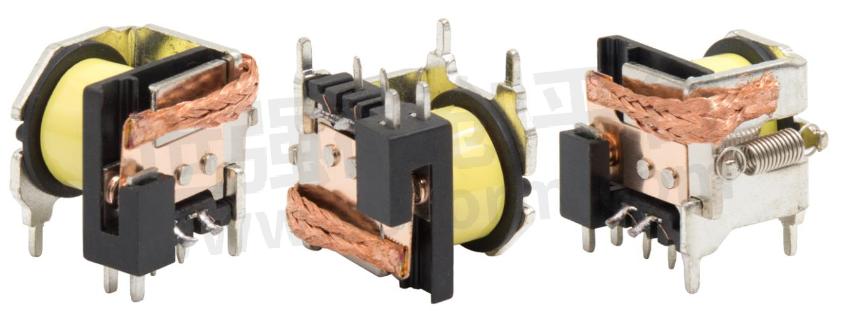Selection Guide for Automotive Relays

When selecting automotive relays, analysis, and research can be carried out item by item according to the following points: shape and installation method, input parameters, output parameters, environmental conditions, electromagnetic compatibility, and installation and use requirements.

Parameter Selection
The input parameters of automobile relays are 12VDC input parameters, 24VDC input parameters, 12VDC pulse input parameters, 24VDC pulse input parameters. Consider the following parameters when selecting: coil rated voltage, coil power consumption, operating voltage, release voltage, maximum continuous energization current, coil resistance, coil temperature rise, the pulse width of pulse input parameters (magnetic latching relay).
Input Parameter Selection Attention:
Ambient Temperature: The operating environment temperature and the temperature rise of the coil affect the operating voltage, generally divided into the engine compartment (maximum temperature requirement is 125℃) and cockpit (maximum temperature requirement is 85℃); relay coil resistance varies with temperature Change and change, this has obvious influence on relay action and release voltage. The resistance of the coil will increase by 4‰ for every 1℃ increase in temperature. When the relay coil is energized for a period of time, the coil heats up. At this time, the relay contact switching action is performed, and its operating voltage is higher than the cold operating voltage.
Operating Voltage: When driving relays with transistors and integrated circuits, pay attention to the destructive effect of the voltage drop of the transistors and integrated circuits and the back EMF of the relay coils on the transistors and integrated circuits.
Coil Rated Voltage: After the normally open contact of the relay is closed, a voltage above the lowest operating voltage is generally required to be applied to the coil. Low holding voltage is not recommended for automotive relays, because it will weaken the product's vibration resistance, and when the car is severely bumped Misoperation may occur.
The Maximum Working Voltage of the Coil: In order to meet the requirement of low operating voltage (60% rated voltage), automotive relays generally have high power consumption. The voltage value applied to the coil for a long time should generally be less than 120% of the rated voltage. When the rated voltage is 130% or above, contact the relay manufacturer for technical support. Especially when used at high temperatures, it will cause the coil temperature to be too high, and the aging will accelerate --eventually, the coil insulation layer will be damaged, and the coil will be short-circuited and become invalid.
Release Voltage: The release voltage of automotive relays is generally 10% of the rated voltage. When the remaining voltage on the line is too large, the relay will not release.
Output Parameter
The following parameters should be considered when selecting relay output parameters: number of contact groups, contact form, contact load, contact material, electrical life, and mechanical life.
Load Type: The load capacity of most domestic relays is only marked with the largest pure resistive load. This gives the user two misunderstandings when choosing a relay load, which leads to a wrong selection. One of the misunderstandings is that what users use is often not purely resistive loads, but inductive, lamp, motor, or capacitive loads. The load size is equal to or close to resistive loads; the second misunderstanding is: that the load can be changed from low power It can adapt to the rated load. It should be pointed out that a relay that can reliably convert a 10A resistive load cannot convert a 10A inductive load, and may not reliably convert a 10mA load. Because the electrical contact failure mechanism under different load conditions is completely different. The power supply of the automobile system adopts a direct current, and the direct current voltage has no zero-crossing point. The moment the contact is opened, an arc is generated, and because the applied voltage is continuously maintained, only the arc is elongated and cannot be self-sustained and extinguished. Arc heat will cause serious burnout of contacts, and DC current will always flow in one direction, which will increase the transfer of contact materials. The load capacity of most automotive relays is only nominally resistive load, but the actual use of automotive relays is often not resistive loads, but inductive loads, lamp loads, and motor loads. Due to the high inrush current, the contact steady-state load The size should be derated according to the size of the inrush current. It should be emphasized that contact failure is the main cause of relay failure. The electrical contact characteristics, failure phenomena, and failure mechanisms of contacts in different load types and different load conditions are different.
Contact Material: The contact material is the most critical material used in the relay, and its performance determines the quality of the relay.
- +1 Like
- Add to Favorites
Recommend
This document is provided by Sekorm Platform for VIP exclusive service. The copyright is owned by Sekorm. Without authorization, any medias, websites or individual are not allowed to reprint. When authorizing the reprint, the link of www.sekorm.com must be indicated.

























































































































































































































































































































































































































































































































































































































































































































































































































































































































